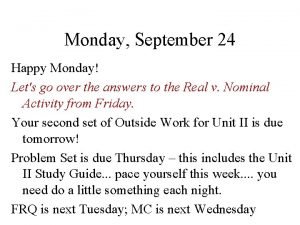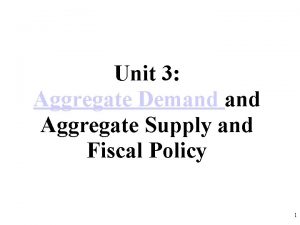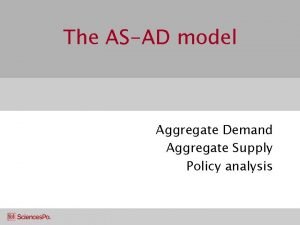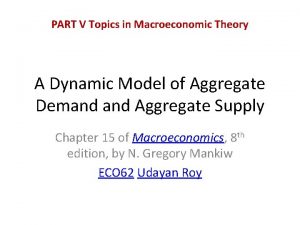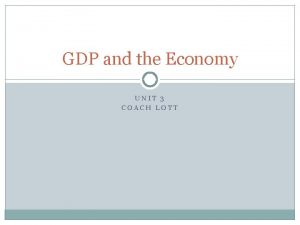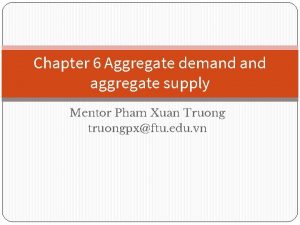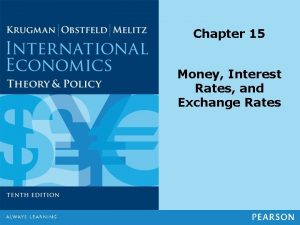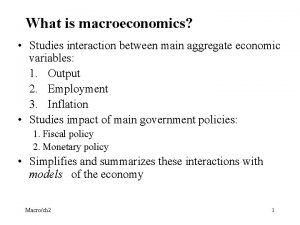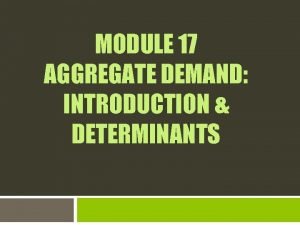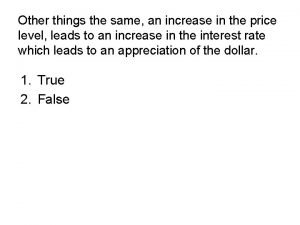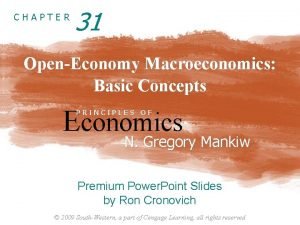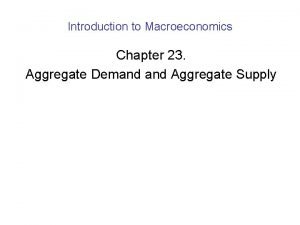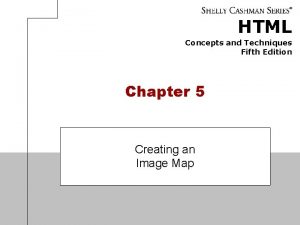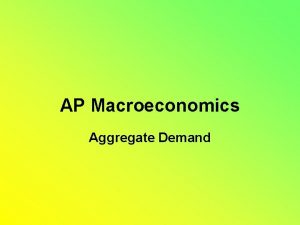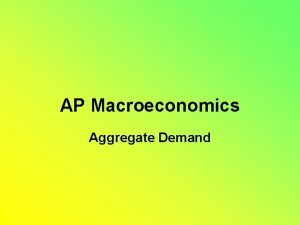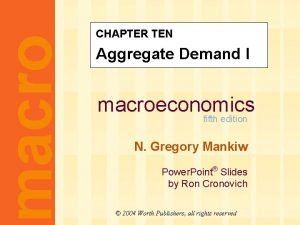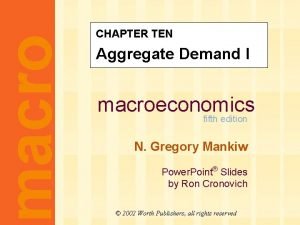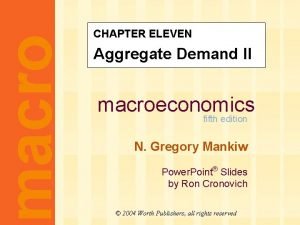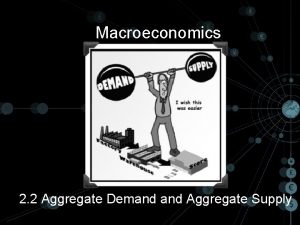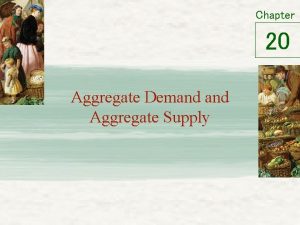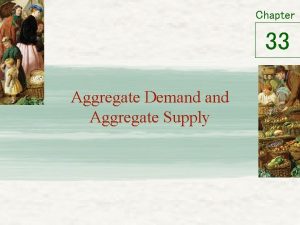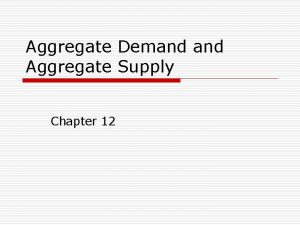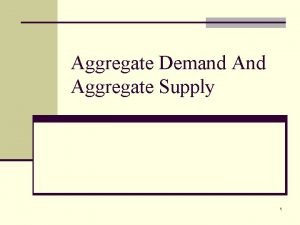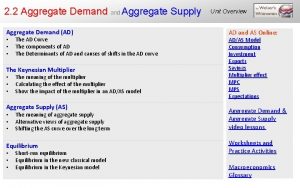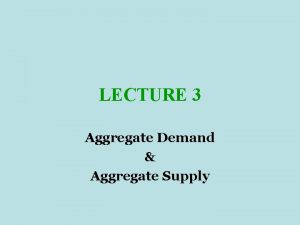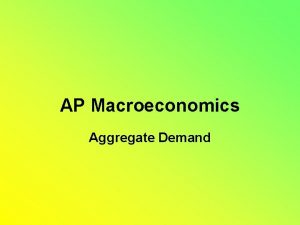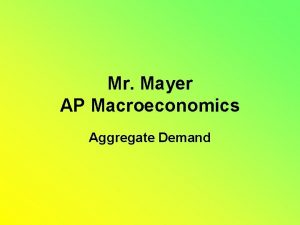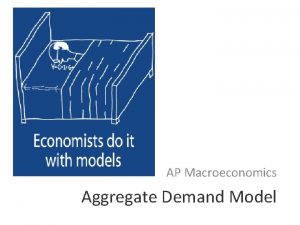macro CHAPTER TEN Aggregate Demand I macroeconomics fifth







































- Slides: 39

macro CHAPTER TEN Aggregate Demand I macroeconomics fifth edition N. Gregory Mankiw Power. Point® Slides by Ron Cronovich © 2002 Worth Publishers, all rights reserved

Context § Chapter 9 introduced the model of aggregate demand aggregate supply. § Long run – prices flexible – output determined by factors of production & technology – unemployment equals its natural rate § Short run – prices fixed – output determined by aggregate demand – unemployment is negatively related to output CHAPTER 10 Aggregate Demand I 2

Context § This chapter develops the IS-LM model, theory that yields the aggregate demand curve. § We focus on the short run and assume the price level is fixed. CHAPTER 10 Aggregate Demand I 3

The Keynesian Cross § A simple closed economy model in which income is determined by expenditure. (due to J. M. Keynes) § Notation: I = planned investment E = C + I + G = planned expenditure Y = real GDP = actual expenditure § Difference between actual & planned expenditure: unplanned inventory investment CHAPTER 10 Aggregate Demand I 4

Elements of the Keynesian Cross consumption function: govt policy variables: for now, investment is exogenous: planned expenditure: Equilibrium condition: CHAPTER 10 Aggregate Demand I 5

Graphing planned expenditure E = C +I +G 1 MPC income, output, Y CHAPTER 10 Aggregate Demand I 6

Graphing the equilibrium condition E E =Y planned expenditure 45º income, output, Y CHAPTER 10 Aggregate Demand I 7

The equilibrium value of income E E =Y planned expenditure E = C +I +G income, output, Y Equilibrium income CHAPTER 10 Aggregate Demand I 8

An increase in government purchases = E E At Y 1, there is now an unplanned drop in inventory… Y E = C + I + G 2 E = C + I + G 1 G …so firms increase output, and income rises toward a new equilibrium CHAPTER 10 Y E 1 = Y 1 Y Aggregate Demand I E 2 = Y 2 9

Solving for Y equilibrium condition in changes because I exogenous because C = MPC Y Collect terms with Y on the left side of the equals sign: CHAPTER 10 Finally, solve for Y : Aggregate Demand I 10

The government purchases multiplier Example: MPC = 0. 8 The increase in G causes income to increase by 5 times as much! CHAPTER 10 Aggregate Demand I 11

The government purchases multiplier Definition: the increase in income resulting from a $1 increase in G. In this model, the G multiplier equals In the example with MPC = 0. 8, CHAPTER 10 Aggregate Demand I 12

Why the multiplier is greater than 1 § Initially, the increase in G causes an equal increase in Y: § But Y Y = G. C further Y further C further Y § So the final impact on income is much bigger than the initial G. CHAPTER 10 Aggregate Demand I 13

An increase in taxes = E Initially, the tax increase reduces consumption, and therefore E: E CHAPTER 10 E = C 1 +I +G E = C 2 +I +G At Y 1, there is now an unplanned inventory buildup… C = MPC T …so firms reduce output, and income falls toward a new equilibrium Y Y E 2 = Y 2 Y Aggregate Demand I E 1 = Y 1 14

Solving for Y eq’m condition in changes I and G exogenous Solving for Y : Final result: CHAPTER 10 Aggregate Demand I 15

The Tax Multiplier def: the change in income resulting from a $1 increase in T : If MPC = 0. 8, then the tax multiplier equals CHAPTER 10 Aggregate Demand I 16

The Tax Multiplier …is negative: An increase in taxes reduces consumer spending, which reduces equilibrium income. …is greater than one (in absolute value): A change in taxes has a multiplier effect on income. …is smaller than the govt spending multiplier: Consumers save the fraction (1 -MPC) of a tax cut, so the initial boost in spending from a tax cut is smaller than from an equal increase in G. CHAPTER 10 Aggregate Demand I 18

Exercise: § Use a graph of the Keynesian Cross to show the impact of an increase in investment on the equilibrium level of income/output. CHAPTER 10 Aggregate Demand I 19

The IS curve def: a graph of all combinations of r and Y that result in goods market equilibrium, i. e. actual expenditure (output) = planned expenditure The equation for the IS curve is: CHAPTER 10 Aggregate Demand I 20

Deriving the IS curve E =Y E =C +I (r )+G 2 E r E =C +I (r 1 )+G I E Y I r Y 1 Y Y 2 r 1 r 2 IS Y 1 CHAPTER 10 Y 2 Aggregate Demand I Y 21

Understanding the IS curve’s slope § The IS curve is negatively sloped. § Intuition: A fall in the interest rate motivates firms to increase investment spending, which drives up total planned spending (E ). To restore equilibrium in the goods market, output (a. k. a. actual expenditure, Y ) must increase. CHAPTER 10 Aggregate Demand I 22

The IS curve and the Loanable Funds model (b) The IS curve (a) The L. F. model r S 2 r S 1 r 2 r 1 I (r ) S, I CHAPTER 10 Aggregate Demand I IS Y 2 Y 1 Y 23

Fiscal Policy and the IS curve § We can use the IS-LM model to see how fiscal policy (G and T ) can affect aggregate demand output. § Let’s start by using the Keynesian Cross to see how fiscal policy shifts the IS curve… CHAPTER 10 Aggregate Demand I 24

Shifting the IS curve: G At any value of r, G E Y …so the IS curve shifts to the right. The horizontal distance of the IS shift equals E =Y E =C +I (r )+G 1 2 E E =C +I (r 1 )+G 1 r Y 1 r 1 Y Y 1 CHAPTER 10 Y Y 2 IS 1 Y 2 Aggregate Demand I IS 2 Y 25

Exercise: Shifting the IS curve § Use the diagram of the Keynesian Cross or Loanable Funds model to show an increase in taxes shifts the IS curve. CHAPTER 10 Aggregate Demand I 26

The Theory of Liquidity Preference § due to John Maynard Keynes. § A simple theory in which the interest rate is determined by money supply and money demand. CHAPTER 10 Aggregate Demand I 27

Money Supply The supply of real money balances is fixed: r interest rate M/P real money balances CHAPTER 10 Aggregate Demand I 28

The LM curve Now let’s put Y back into the money demand function: The LM curve is a graph of all combinations of r and Y that equate the supply and demand for real money balances. The equation for the LM curve is: CHAPTER 10 Aggregate Demand I 34

Deriving the LM curve (a) The market for r real money balances (b) The LM curve r LM r 2 L ( r , Y 2 ) r 1 L ( r , Y 1 ) M/P CHAPTER 10 Aggregate Demand I Y 1 Y 2 Y 35

Understanding the LM curve’s slope § The LM curve is positively sloped. § Intuition: An increase in income raises money demand. Since the supply of real balances is fixed, there is now excess demand in the money market at the initial interest rate. The interest rate must rise to restore equilibrium in the money market. CHAPTER 10 Aggregate Demand I 36

How M shifts the LM curve (a) The market for r real money balances (b) The LM curve r LM 2 LM 1 r 2 r 1 L ( r , Y 1 ) M/P CHAPTER 10 Aggregate Demand I Y 1 Y 37

Exercise: Shifting the LM curve § Suppose a wave of credit card fraud causes consumers to use cash more frequently in transactions. § Use the Liquidity Preference model to show these events shift the LM curve. CHAPTER 10 Aggregate Demand I 38

The short-run equilibrium is the combination of r and Y that simultaneously satisfies the equilibrium conditions in the goods & money markets: r LM IS Y Equilibrium interest rate CHAPTER 10 Aggregate Demand I Equilibrium level of income 39

The Big Picture Keynesian Cross Theory of Liquidity Preference IS curve LM curve IS-LM model Agg. demand curve Agg. supply curve CHAPTER 10 Aggregate Demand I Explanation of short-run fluctuations Model of Agg. Demand Agg. Supply 40

Chapter summary 1. Keynesian Cross § basic model of income determination § takes fiscal policy & investment as exogenous § fiscal policy has a multiplied impact on income. 2. IS curve § comes from Keynesian Cross when planned investment depends negatively on interest rate § shows all combinations of r and Y that equate planned expenditure with actual expenditure on goods & services CHAPTER 10 Aggregate Demand I 41

Chapter summary 3. Theory of Liquidity Preference § basic model of interest rate determination § takes money supply & price level as exogenous § an increase in the money supply lowers the interest rate 4. LM curve § comes from Liquidity Preference Theory when money demand depends positively on income § shows all combinations of r and. Y that equate demand for real money balances with supply CHAPTER 10 Aggregate Demand I 42

Chapter summary 5. IS-LM model § Intersection of IS and LM curves shows the unique point (Y, r ) that satisfies equilibrium in both the goods and money markets. CHAPTER 10 Aggregate Demand I 43

Preview of Chapter 11 In Chapter 11, we will § use the IS-LM model to analyze the impact of policies and shocks § learn how the aggregate demand curve comes from IS-LM § use the IS-LM and AD-AS models together to analyze the short-run and long-run effects of shocks § learn about the Great Depression using our models CHAPTER 10 Aggregate Demand I 44

CHAPTER 10 Aggregate Demand I 45
 Shift in sras curve
Shift in sras curve How to calculate aggregate demand
How to calculate aggregate demand Unit 3 aggregate demand aggregate supply and fiscal policy
Unit 3 aggregate demand aggregate supply and fiscal policy Tax multiplier formula
Tax multiplier formula Unit 3 aggregate demand aggregate supply and fiscal policy
Unit 3 aggregate demand aggregate supply and fiscal policy Cannot mix aggregate and non aggregate tableau
Cannot mix aggregate and non aggregate tableau Ap macroeconomics supply and demand analysis
Ap macroeconomics supply and demand analysis Econmovies episode 6 worksheet answers
Econmovies episode 6 worksheet answers Macro processors
Macro processors Why is aggregate demand downward sloping
Why is aggregate demand downward sloping Asad model
Asad model Dad das model
Dad das model Aggregate demand curve
Aggregate demand curve Recessionary gap aggregate demand
Recessionary gap aggregate demand Aggregate of chapter 6
Aggregate of chapter 6 Aggregate supply shifters
Aggregate supply shifters Aggregate supply and demand graph
Aggregate supply and demand graph The aggregate real money demand schedule l(r,y)
The aggregate real money demand schedule l(r,y) The aggregate real money demand schedule l(r,y)
The aggregate real money demand schedule l(r,y) Money market graph expansionary monetary policy
Money market graph expansionary monetary policy Aggregate planning strategies
Aggregate planning strategies Real gdp formula
Real gdp formula Aggregate demand curve
Aggregate demand curve Which of the following shifts aggregate demand to the left?
Which of the following shifts aggregate demand to the left? It's twenty to eight
It's twenty to eight Ten ten siempre fuerzas y esperanza
Ten ten siempre fuerzas y esperanza Am i a 10/10
Am i a 10/10 Chapter 31 open economy macroeconomics
Chapter 31 open economy macroeconomics Macroeconomics chapter 7
Macroeconomics chapter 7 Macroeconomics chapter 8
Macroeconomics chapter 8 Macroeconomics chapter 23
Macroeconomics chapter 23 The harder you push the harder the system pushes back
The harder you push the harder the system pushes back Fifth chapter menu
Fifth chapter menu Stochastic inventory model example
Stochastic inventory model example Measures to correct excess and deficient demand
Measures to correct excess and deficient demand Market demand curve
Market demand curve Independent vs dependent
Independent vs dependent Mathematical equation ng presyo at demand
Mathematical equation ng presyo at demand Dependent demand vs independent demand
Dependent demand vs independent demand Module 5 supply and demand introduction and demand
Module 5 supply and demand introduction and demand







